North Woods Naturalist


Arts, cultural and history features on WTIP are made possible in part by funding from the Minnesota Arts and Cultural Heritage Fund. Check out other programs and features funded in part with support from the Heritage Fund.
North Woods Naturalist: Late bird migration
-Late fall offers a chance to see some birds that we normally don't see along the North Shore. Some late migratory birds include eagles, northern harriers, hawks, and many more. WTIP's CJ Heithoff talks with naturalist Chel Anderson about late bird migration in this edition of North Woods Naturalist.
North Woods Naturalist: Moose and nutrient cycles
-Moose contribute to the nutrient cycle in the forest in many ways. WTIP's CJ Heithoff learns more from naturalist Chel Anderson in this edition of North Woods Naturalist.
North Woods Naturalist: Fall recap
-WTIP's CJ Heithoff talks with naturalist Chel Anderson about the fall season so far, including what reasons may have contributed to the spectacular fall colors we enjoyed in this edition of North Woods Naturalist.
Brook trout spawn is on in cold streams
-This edition of North Woods Naturalist was originally posted on October 12, 2010.
Chel Anderson is a botanist and plant ecologist for the Minnesota Department of Natural Resources. She lives here in Cook County and joins us periodically to talk about phenology or what’s going on in the woods right now. Welcome, Chel.
North Woods Naturalist: Monarchs
-WTIP's CJ Heithoff talks with naturalist Chel Anderson about the incredible migration journey that Monarchs go on every year in this edition of North Woods Naturalist.
Fall is time for the annual moose rut
-Originally posted October 5, 2010.
Chel Anderson is a botanist and plant ecologist for the Minnesota Department of Natural Resources. She lives here in Cook County and joins us periodically to talk about phenology or what’s going on in the woods right now. Welcome, Chel.
North Woods Naturalist: Yellow birch
-It's the fall color season along the North Shore! WTIP's CJ Heithoff talks with naturalist Chel Anderson about a particular tree that can stand out this time of year, the Yellow birch, in this edition of North Woods Naturalist.
Photo credit:
Nicholas A. Tonelli from Northeast Pennsylvania, USA - Foliage Walk (15), CC BY 2.0, commons.wikimedia.org/w/index.php?curid=61600613
North Woods Naturalist: Gypsy Moths
-If you've been outside at night with a light on recently, you've likely encountered gypsy moths. Did you know that these moths only live for about two weeks? WTIP's CJ Hiethoff talks with naturalist Chel Anderson about the invasive species in this edition of North Woods Naturalist.
North Woods Naturalist: Humongous fungus
-Honey mushrooms and other fungi have been found in abundance this year. WTIP's CJ Heithoff talks with naturalist Chel Anderson about the world of fungi in this edition of North Woods Naturalist.
North Woods Naturalist: Indian Pipe
-Monotropa uniflora, known to many as Indian Pipe or Ghost Plant is a perennial wildflower found throughout the United States. However, according to the U.S. Forest Service, it's not a commonly encountered wildflower.
There have been some sightings of this white wildflower in our area recently. WTIP's CJ Heithoffs talks with naturalist Chel Anderson about Indian Pipes in this edition of North Woods Naturalist.










_(29719042493).thumbnail.jpg)


